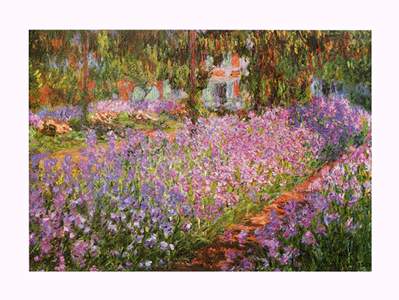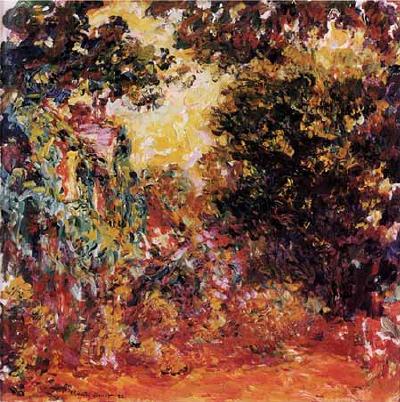Report on a lecture entitled A Site for Sight: Monet
in His Garden at Giverny, and given by Michael Marrinan, associate
professor of art and art history, during a talk on 3/13/01 in the auditorium
of the Cantor Center for Visual Arts as part of the Department of Art and
Art History's Faculty Talks series. Courtesy of John Sanford, writer, News
Service of Stanford University.

The boat on the lily pond at Giverny, photo Anne
Chrysotème |
Every morning, a gardener would boat around the pond next to Claude Monet's
house in Giverny, meticulously cleaning water lilies that had collected soot
from passing trains. The master insisted that, when he got out in his boat
in the morning, the water lilies would be pristine.
Monet moved to Giverny, a village along the Seine about 46 miles to the west
of Paris, in 1883. Here, he designed a pond, redesigned much of the garden
and, most famously, created those paintings of water lilies, flower beds
and the Japanese footbridge.
However, many of these later works do not fit the classic definition of
Impressionism. Monet's technique underwent an enormous change while at Giverny. |
| Impressionism, a style of painting that originated in France in the 1870s,
is characterized by small brush strokes aimed at reproducing reflected light
and, more important, the artist's visual "impression" of an immediate scene
(usually outdoors). Monet is considered one of the founders of the style.
But at Giverny, Monet's work increasingly begins to reflect his memory and
emotions, rather than an impression of a transitory scene. Monet's painting
style also became more "physical": The minute brushstrokes of his earlier
work give way to broader brushstrokes. If the 1870s were about wrist movements
..., the 1920s were about body gestures.
Along with the more "physical" motion of the brush, Monet's canvases grew
larger, requiring more physical movement on the part of the viewer. Monet
created the Grandes
Décorations (1918-1926) - sweeping, large-scale paintings of light
and images reflected in his lily pond - on panels more than 6 feet high and
9 feet wide. The paintings were intended to surround viewers, who would have
to walk around a gallery to look at them. |

"Nymphéas", circ.1920 (detail) Musée Marmottan,
Paris |

"Le Jardin de Monet, les iris" Claude MONET (1900) Musée d'Orsay,
Paris |
Monet felt more liberated to experiment with technique to use
larger canvases and rely less on constantly checking a motif because,
in his garden, he could control nature. Here, a motif was not the result
of an accident but, rather, the result of deliberate organization: Monet
designed the flower beds and coordinated the colors. When a white lily petal
was soiled by soot, it was wiped clean.
The garden was planted in light of paintings not yet painted, and paintings
took on a kind of audacity in light of the fact that they were responding
to a garden that had already been organized. So you get this kind of reciprocal
relationship between gardening and painting. Monet ranged more widely with
his technical experimentation than when he was facing the chaos of what we
may call raw nature. In this way, the garden was more than a subject, but
it was a site a site for a specific way of seeing and, finally, a
specific way of painting. |
| Let us compare Monet's "Boulevard des Capucines" (1873), a classic
Impressionist work, to one of the 1908 water-lily paintings.
The 1873 work depicts a street scene from above. Men leaning over a balcony
in the right-hand side of the painting have roughly the same view of the
scene as we do.
In this work, Monet packed the information of a transitory moment into the
frame. The painting also depicts a specific place. |

"Carnaval, Boulevard des Capucines à Paris"
Claude Monet. (1873) Pouchkine Museum, Moscow |
 "Nympheas" (detail) Claude Monet (1908) Private collection
"Nympheas" (detail) Claude Monet (1908) Private collection |
The water lilies, on the other hand, offer no such set of geographical
coordinates; they are more dreamlike - less reflective of a specific place
and point of view. Indeed, it is doubtful that Monet was checking his motifs
very often while engaged in some of his later works at Giverny.
For Monet, the garden was a living still life that freed him to plumb the
depths of his memory and emotions, rather than simply record his "impression"
of a scene.
In the same way, the series of hut-shaped haystacks Monet painted between
1890 and 1891 were, by roughly the same definition, still lifes. The hay
would remain in the same form day after day. Here, we find Monet daring to
experiment with color and technique in new ways. |
Monet no longer feels that he has to pack the image with perceptual data
so as to maximize the effect of our 'instant of recognition. A new kind of
duration develops in these pictures over a series of canvases. Memory,
rethinking, double-backing and moving through space all become part of the
act of seeing. Similarly, when working on the series of paintings of the
Rouen cathedral between 1892 and 1894, Monet could improvise with his painting
technique, using as his motif the unchanging façade of the church.

"La maison vue du jardin aux roses" Claude Monet (1922-1924)
Musée Marmottan, Paris |
In 1912, Monet was diagnosed with a cataract in his right eye. Eventually,
cataracts affected both eyes. The painter's failing vision pushed him even
more in the direction of depicting memory and emotion.
Monet's later paintings of the weeping willow, the wisteria and the Japanese
footbridge, among other denizens of his garden, should not be considered
geographical landmarks. Rather, they reflect the complex of sensations and
memories left over - what we take away --when we visit the garden.
Many of these later paintings verge on the abstract, with colors bleeding
into each other and a lack of rational shape and perspective. For example,
"The House Seen from the Rose Garden, 1922-1924," is an explosion of orange,
yellow and red hues, but leaves the reader barely able to discern the vague
shape of the house in the background.Monet's diminished sight opened up a
new vista for his art, one in which memory and the unseen play a more important
role than the perceptions of direct experience.
In a certain sense, we must learn to see these last pictures of his garden
at Giverny not as increasingly confused by his inability to see clearly,
but as pictures in which Monet's memory traces of the site he had planted
and tended and lived with so long - the paths, the plants and the waterways
of his garden - came to replace the ever more fragile images of his failing
eye. |
Report by John Sanford, lecture by Michael Marrinan. Stanford University |
|
![]() A visit to Claude Monet's garden
A visit to Claude Monet's garden![]() List of plants and flowers of Claude Monet's
garden
List of plants and flowers of Claude Monet's
garden![]() Flowering calendar in Claude Monet's garden
Flowering calendar in Claude Monet's garden![]() Claude Monet's garden in
Autumn
Claude Monet's garden in
Autumn![]() Map of Claude Monet's garden (91Kb)
Map of Claude Monet's garden (91Kb)![]() Aerial View of Claude Monet's garden (78
Kb)
Aerial View of Claude Monet's garden (78
Kb)![]() Tips and tricks
Tips and tricks![]() Talk : Giverny, place of memory
Talk : Giverny, place of memory
